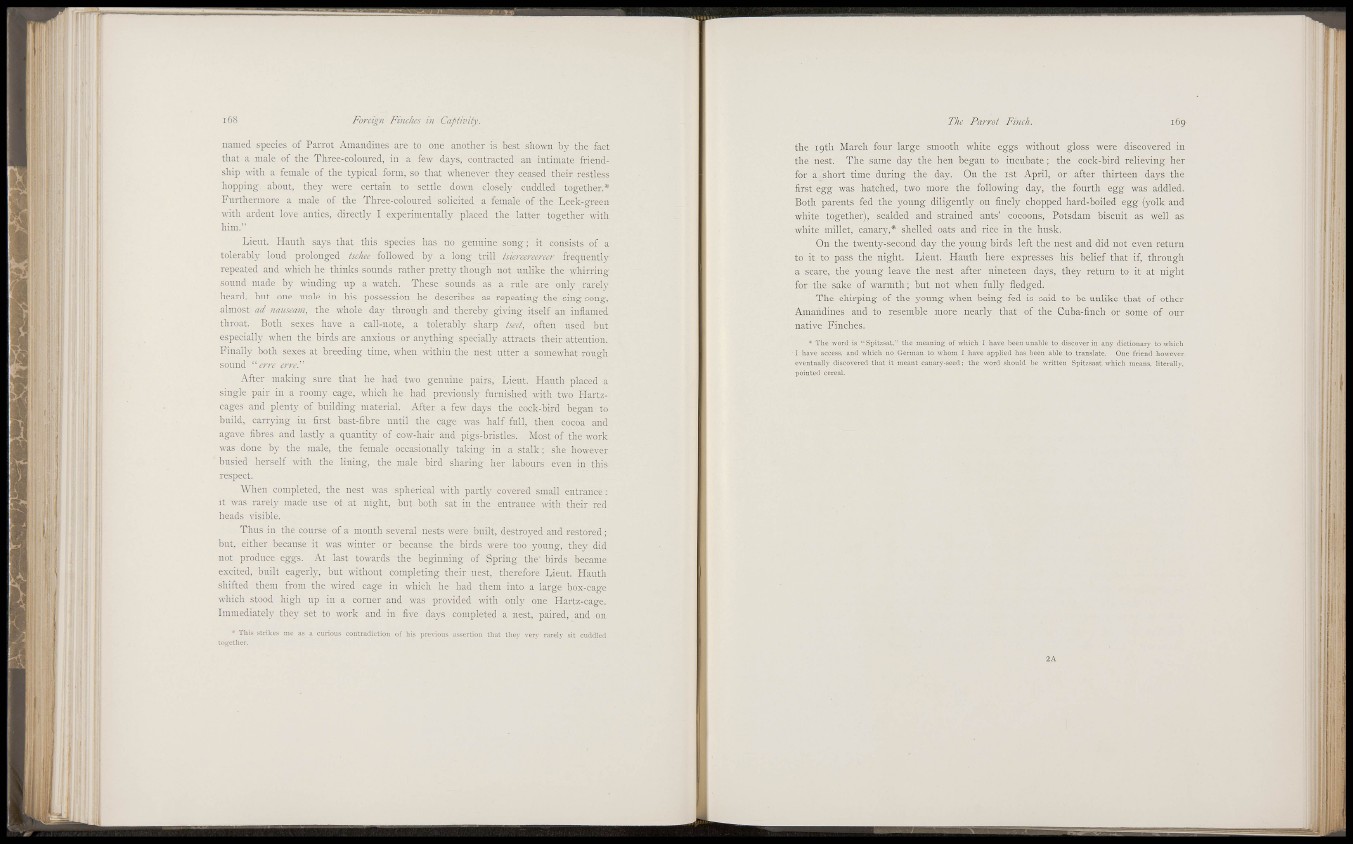
168 Foreign Finc/ics in Captivi/y.
\ i
named species of Parrot Aiuaudines are to one another is best shown b}- the fact
that a male of the Three-colonred, in a few days, contracted an intimate friendship
with a female of the tj-pical form, so that whenever they ceased their restless
liopping about, they were certain to settle down closely cnddled together.*
Fnrthermore a male of the Three-colonred solicited a female of the Leek-green
with ardent love antics, directly I experimentally placed the latter together with
him."
Lient. Hanth says that this species has no genuine song ; it consists of a
tolerably loud prolonged isclnr followed by a long trill tsicrcerecrecr frecpientl)-
repeated and which he thinks sounds rather pretty- though not unlike the whirring
sound made by winding up a watch. These sounds as a rule are onl}- rarely
heard, but one male in his possession he describes as repeating the sing-song,
almost ad nauseam, the whole day through and thereby- giving itself an inflamed
throat. Both sexes have a call-note, a tolerabl}' sharp iscel, often used but
especialh' «dien the birds are anxious or anything specially attracts their attention.
Finall}- both sexes at breeding time, when within the nest utter a somewhat rough
sound " crre cm."
After making sure that he had tvo genuine pairs, Lient. Hanth placed a
single pair in a roonu' cage, which he had previonslv furnished with two Hartzcages
and plenty- of building material. After a few days the cock-bird began to
build, carrying in first bast-fibre until the cage ^vas half full, then cocoa and
aga\-e fibres and lastl}- a cpiantit}' of cow-hair and pigs-bristles. Most of the work
w^as done by the male, the female occasionally taking in a stalk; she however
busied herself \vith the lining, the male bird sharing her labours e^-en in this
respect.
When completed, the nest was spherical with partly covered small entrance :
it was rarel}- made use of at night, but both sat in the entrance ^\dth their red
heads visible.
Thus in the course of a month several nests were built, destro^'ed and restored;
but, either because it was winter or because the birds were too young, they did
not produce eggs. At last towards the beginning of Spring the birds became
excited, built eagerl3', but without completing their nest, therefore Lieut. Hanth
shifted them from the ^vired cage in which he had them into a large box-cage
\vhich stood high up in a corner and was provided with only one Hartz-cage.
Inunediatel}- they set to work and in five days completed a nest, paired, and on
" This strikes nie as a curious contradictiou of his previous assertion that thej- very rarel}- sit cuddled
to.iiether.
The Parrot Finch. 169
the 19th March four large smooth white eggs without gloss were discovered in
the nest. The same day the hen began to incubate ; the cock-bird relieving her
for a short time during the day. On the ist April, or after thirteen daj's the
first egg was hatched, two more the following day, the fourth egg was addled.
Both parents fed the young diligentl}' on finely chopped hard-boiled egg (yolk and
white together), scalded and strained ants' cocoons, Potsdam biscuit as well as
white millet, canary,* shelled oats and rice in the husk.
On the twenty-second day the young birds left the nest and did not even return
to it to pass the night. Lieut. Hauth here expresses his belief that if, through
a scare, the young leave the nest after nineteen days, they return to it at night
for the sake of warmth ; but not when fully fledged.
The chirping of the young when being fed is said to be unlike that of other
Amandines and to resemble more nearly that of the Cuba-finch or some of our
native Finches.
* The word is "Spil/.sat," the uteauiug of which I have been unable to discover iu any dictionary to which
I have access, and which no Geruian to whom 1 have applied has been able to trau.slate. One friend however
eventually discovered that it meant cauarv-seed; the word should be ^vritten vSpitzsaat which means, literallv,
pointed cereal.
i